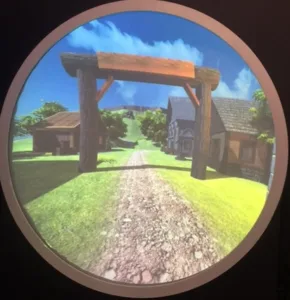I’ve noticed at many tech conferences the steady and slow gait towards the ‘prosumer’ in education, the growing validity of and demand for student-created content. Take ISTE 2018, for example. At the largest ed-tech conference in the U.S. with more than 1850+ in attendance, the majority of VR sessions focused on student-generated content, not commercially available content.

While many companies fire away in a dogged rush to sell VR experiences and content to classrooms across the world, educators are often pursuing an entirely different pathway: the pathway of creating their own VR. This is especially true for folks in higher education.
The student-generated VR content meme is growing at ed-tech conferences
My same observations held true even at the bustling InfoComm 2018 exhibit hall, where a careful balance appeared between these two forces: the prosumer and consumer of VR. One of the most interesting products in this regard, quite appealing to the education market, was prominently displayed in the Canon booth: Zaxel’s zDome Uni. The zDome Uni (pictured below) is a display solution capable of displaying 360° video for group viewing. It uses a vertically placed dome and one short throw projector placed by the side of the dome or hung from the ceiling to fill the entire dome with a pleasantly immersive experience.
Zaxel’s zDome uni with interactive 360 video content on display
Now, before I continue, let me address the problems the zDome solves. Two of the related challenges facing the development of student-generated content in our nation’s classrooms involve the difficulties of (1) displaying 360° or VR content, as generated by students, and 2) social learning in the VR environment. According to Dr. Norihisa Suzuku, President and CEO of Zaxel Systems,
“Current virtual reality video can only be fully observable using VR goggles. This setup has problems because the video being observed cannot be shared with other students, and cannot be used for casual viewing at museums, aquariums or in show windows.” He clarifies, “zDome provides similar immersive experiences and ‘3D illusions’ without wearing goggles.”
The ability to display students work, authored in VR or 360° video/photography formats, addresses a real pain point in the world of student-created content. In addition, the immersive nature of the medium is preserved. Suzuki explains that the zDome provides “immersive views of video since peripheral objects go to the background as the view point goes forward.” He adds, “when using a 3D projector or two projectors [in the solution], viewers can experience stereoscopic content on zDome.”
The zDome Uni was featured in the Canon exhibit at IC18
A second problem solved by the zDome addresses the need for social learning in classrooms or museums. In my recent DD article, “A Casting Call for Social VR in the Classroom”, I tell the story of teachers who often lament
“Most VR seems to be an individual experience, but I want my entire class to enjoy this, with me [the teacher] included.”
The zDome allows just that. Multiple students (and the teacher) can experience, analyze, discuss, and provide feedback on VR environments that previously are typically can only be experienced in the isolated crevices of individual VR headgear.
The zDome I observed at InfoComm 2018 was a 46“ display, which I thought, at first, would be a bit constrained for larger groups. In a follow-up interview Suzuki stated,
“We have demonstrated zDome with a 60“ display [with a 30“ depth] at NAB last year. The maximum size we can make of the same material, plastic, is 69“ in the U.S. But we have made and are selling 70“ zDomes in Japan.”
Already in production in Japan, the zDome will appear on the Zaxel U.S. website by the end of July. They plan to demonstrate it again in November at InterBee in Japan and ITSAC in Orlando, FL.
Now that a keen interest for student-generated VR content is reaching an all-time high, it’s an extremely positive development that we can view that content in groups, without the heavy and management-intensive headgear.—Len Scrogan

